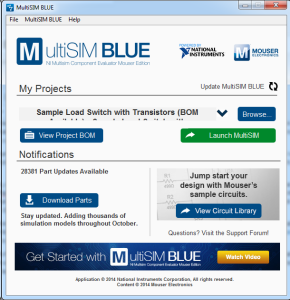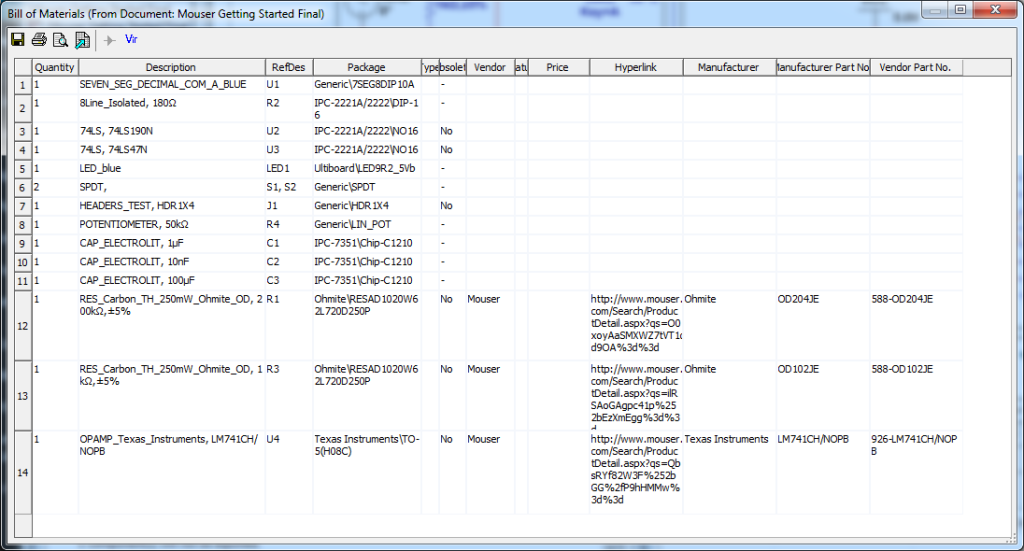Before you order your circuit boards, visit our PCB Price Calculator. You can enter the size, layers, and quantity of your board and get prices from 17 different PCB manufacturers instantly.
 I was excited when I heard that Mouser was releasing a free version of National Instruments’ MultiSIM PCB CAD software. From Mouser’s web site, it seemed this would be an unlimited CAD package, with the bonus feature of being integrated with Mouser’s parts catalog for easy component selection and ordering. So when it became available, I eagerly downloaded it. Alas, I was sorely disappointed.
I was excited when I heard that Mouser was releasing a free version of National Instruments’ MultiSIM PCB CAD software. From Mouser’s web site, it seemed this would be an unlimited CAD package, with the bonus feature of being integrated with Mouser’s parts catalog for easy component selection and ordering. So when it became available, I eagerly downloaded it. Alas, I was sorely disappointed.
Mouser’s link for downloading MultiSIM BLUE takes you to National Instruments’ website. There, you need to create an account to access the download. They want your e-mail address, but after a few days, they haven’t sent me any spam and they subscribe you to some newsletters. It’s easy enough to unsubscribe later.
While installing, you need to accept two licenses. The licenses state that the PCB layout program, Ultiboard, expires in one year, and that the rest of MultiSIM BLUE expires in July, 2017. I contacted Mouser and they said their contract with NI extends to 2017. Until then, they expect to get updates that will extend the license on Ultiboard. Of course, it remains to be seen whether Mouser and NI will renew their contract in 2017. If not, you’ll be switching to another CAD program.
The programs installed are Multisim Component Evaluator and Ultiboard Component Evaluator. I Googled for “Component Evaluator” and found that NI previously created a Component Evaluator version of MultiSIM for Analog Devices, too. Analog Devices’ version expired in May, 2014 and is not being renewed. That doesn’t give me warm and fuzzy feelings about Mouser’s deal after 2017.
Also installed is the NI Error Reporting Server, which runs all the time, and NI Update Service which runs when your system starts up. This strikes me as poor design: the error reporting server should run only when MultiSIM is running, and the update service should run only when you launch MultiSIM. However, they don’t seem to be consuming much memory or processor time.

The first dialog MultiSIM BLUE displays allows you to load a couple of sample projects, see notifications, view Mouser’s circuit library, and work with BOM (Bill of Materials) files. The notification I saw was that there were parts to download. Since a major attraction of MultiSIM BLUE is its integration with Mouser’s catalog, I decided to do that first. The download progress bar displayed behavior I have never seen before. Despite that, the parts download did, indeed, work. Next, I launched MultiSIM.
In the main window, I went straight to Help – I’m not proud. There, I found the Release Notes which describe the limitations imposed on this version of MultiSIM compared to the Power Pro version. The most important ones are:
- Maximum of 65 components per schematic, not counting grounds and power sources.
- Single-sheet designs only, no multi-page circuits or subcircuits.
- Only two custom components can be created per design, and they can not be saved to a parts database for reuse in other designs.
- Custom components must have standard footprints. That is, the footprint for a custom component must be chosen from the database of existing footprints. It is not possible to create a custom footprint.
- A PCB layout cannot be updated with changes in the schematic. So if you design your circuit, layout your PCB, then change something in your circuit such as adding a resistor, you need to completely re-layout your PCB from scratch. (You also cannot do the reverse – make a change to your PCB and update the schematic to match – but I consider that a less important feature.)
How serious is the restriction on creating custom components? If every part that Mouser sells were in MultiSIM BLUE’s parts database, perhaps it wouldn’t be so bad. Yes, I have occasionally used parts that are not sold by Mouser or Digi-Key, but I don’t think it’s ever been more than two components on a single board.
Unfortunately, the downloaded parts database doesn’t include everything in Mouser’s catalog. The Mouser database has 99,000+ components (as of 10/2014 – presumably, more will be added). That’s a lot, but it’s not enough. Under Microcontrollers, for example, Mouser’s database lists 573 Microchip PICs (8, 16, and 32 bit) but nothing from any other manufacturer. MultiSIM’s own Master database, which has been pared down from the database you would get in a paid version, doesn’t have any microcontrollers in it at all. Do you want an ARM or an AVR or an 8051? I’m sure Mouser will add them at some point, but they’re not there yet. Lots of basic logic ICs, like 74LSxxx chips, are missing too.
Let’s talk about the Bill of Materials and integration with Mouser’s ordering system. When you add a component to your schematic, you can add it from the Master database or the Mouser database (assuming the part is in either of the databases). Everything in the Mouser database has a footprint and a Mouser part number. This is great for something specific like an LF147J op amp, but it’s a bother for a more generic component like a resistor. As you can see in the following component selection dialog, Mouser’s database forces you to choose not only the resistance value, but the type of resistor (e.g. carbon) and the manufacturer.
That’s probably more than you want to do when you’re first designing a circuit. But you don’t have to – you can choose a generic resistor from the Master database and change it later. Many components in the Master database have footprints, but of course none have Mouser part numbers.
Components with a footprint show up in the Bill of Materials. Components without a footprint are called virtual components; they can also be viewed in the BOM, but separately, by clicking the cryptically labeled ‘Vir’ button:
The integration between the BOM and Mouser is a little clumsy. You can’t get prices from Mouser in the above dialog. Instead, you must save the BOM in a file, then open it by clicking the View Project BOM button in the first dialog box (from the beginning of this review). You can then see Mouser’s prices for components that have Mouser part numbers, and add those parts to a Mouser shopping cart, which it does by opening up your browser. You cannot get prices for components that do not have Mouser part numbers – you would need to go back to the schematic, replace the part with something from the Mouser database, then re-generate the BOM.
I’ve come this far and said nothing about the schematic capture or PCB layout tools. There’s really not much to say. You drop components on the schematic, drag them around, wire them up, transfer the schematic to the PCB layout program, drag them around some more, draw traces manually or autoroute, and export the Gerber. If you’ve used a PCB CAD program before, there’s nothing remarkable about using MultiSIM.
Conclusion
There are two types of free CAD programs: limited versions of commercial software, and unlimited, generally open-source, software. My initial hope was that MultiSIM BLUE was unlimited and would therefore compete with unlimited open-source packages. It doesn’t. MultiSIM BLUE’s limits mean that it competes with the free versions of Eagle, DipTrace, etc., and not with KiCad or gEDA.
MultiSIM BLUE’s limit of 65 components is not as bad as Eagle Light Edition’s limit of 4″ × 3.2″, and is on par with the pin limits in many other free versions of commercial software. The restrictions on custom components are more serious. Mouser has the ability to alleviate this shortcoming by adding parts to the Mouser database. As of Oct. 2014, the parts database is inadequate – Mouser needs to get more components into it, and quickly. The fact that changes to a schematic cannot be propagated to an existing PCB layout is very annoying, but some hobbyists working with small circuits might be willing to tolerate it.
The fact that MultiSIM BLUE might stop working altogether in 2017 is a big negative. I could understand that, if Mouser does not extend its contract with National Instruments, there would be no more updates to MultiSIM BLUE. But to shut down a functioning program (and a crippled, three-year-old one, at that) on a user’s system is just spiteful.
So why choose MultiSIM BLUE over the competition? The only unique feature it offers is the integration with the Mouser catalog. Even if that included the entire catalog, it would be a nifty convenience at best; it’s certainly not a must-have feature and it doesn’t compensate for MultiSIM BLUE’s limitations.
Mouser told me “MultiSIM BLUE is a free utility for laying out simple circuits. It is not meant to replace an existing, full-feature solution from another supplier.” Well, why not? It’s in Mouser’s interest to make it easy for people to order parts from them. Why not have a full-featured CAD program that is integrated with Mouser? In Mouser’s defense, I don’t think they’re the bad guy here. National Instruments is undoubtedly the source of the choices for crippling MultiSIM BLUE.
I suspect that Mouser does not have many software engineers, and so they relied on NI to do the Mouser integration – work that was similar to what NI had done earlier for Analog Devices, and therefore probably did not cost a lot. Maybe Mouser had no other viable options, but I wish the outcome had been different. Perhaps they could have integrated their catalog with Eagle Light (owned by Farnell, so it ain’t gonna happen). Or perhaps one of the many free CAD programs that are locked to specific PCB manufacturers could have been produced in an unlocked version, integrated with Mouser’s catalog. Or, finally, perhaps KiCad could have been used as a platform. That would have been sweet.



Useful review; thanks!
Guess I’ll be sticking with Eagle for now. I make my own components in Eagle all the time – honestly it’s often quicker than finding an existing part online (I can do one in 5 min or so).
And personally, I find the 4×3.2″ limit on the Light version preferable to a pin count or component limit – at least I know whatever I can stuff into that size board will be allowed (and I can easily get more than 64 0603 components in that space).
I’d like to know what you think of KiCad or other true open source alternatives.
hi,
thanks for the informed review – you compare to eagle, have you experience of DesignSpark?
Thanks
The documentation does say 2, but in my experience I’m able to create up to 6 custom components in any given design.
It must be a typo or something in the release notes.
Wow I’m glad I read this. I could just about live with the 65 part limit, and I just discovered the deal-breaking lack of forward/back annotation. But no custom footprints?! There’s no point using this software. Very annoying of them to hide the limitations away so much.
Designspark PCB has no such limitations. It’s not nearly as nice a piece of software but at least you can use it!
I still waiting for more components that supposed to be added since October 2014. Looks like something gross happened to this project and wont be further developed.